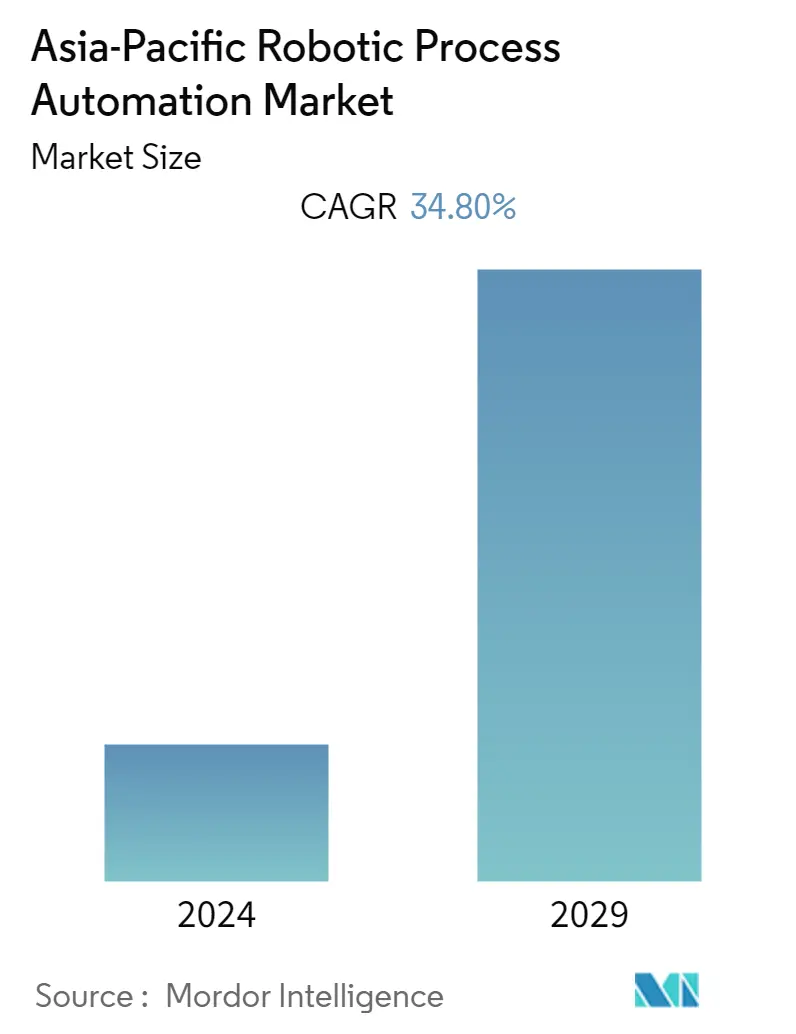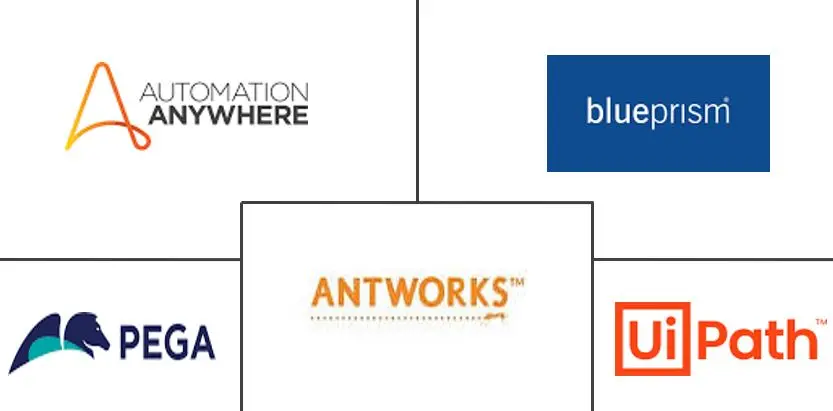Market Size of Asia-Pacific Robotic Process Automation Industry

| Study Period | 2019 - 2029 |
| Base Year For Estimation | 2023 |
| Forecast Data Period | 2024 - 2029 |
| Historical Data Period | 2019 - 2022 |
| CAGR | 34.80 % |
| Market Concentration | Medium |
Major Players
*Disclaimer: Major Players sorted in no particular order |
APAC Robotic Process Automation (RPA) Market Analysis
The Asia-Pacific Robotic Process Automation Market will register a CAGR of 34.8% during the forecast period. Robotic process automation deals with implementing smart software to perform high-volume and repetitive tasks that usually take a lot of time to achieve for humans and are generally monotonous to execute on the market for robotic process automation.
- The robotic process automation (RPA) market is expected to grow in Asian countries owing to increasing focus on and adoption of a digital workforce and rising functional benefits of RPA solutions for business process automation across various end-user industries.
- RPA adoption in the region is fueled by the need to automate intricate business processes across various industries, the convenience of doing business, and the falling costs of automation software and services.
- Vendors in the market are improving their products by including new features in Citrix automation, automation lifecycle management, workload management, credential management, SLA-based automation, and new data APIs. These improvements are drawing in new sectors of industry that demand more operational and security capabilities.
- Moreover, the adoption rate of RPA in enterprises facing challenges and inefficiencies with legacy systems is rising. The benefits offered by the SPA not only increase the organization's productivity but also enable them to focus on its core business activities.
- There will be data security concerns such as data breaches; social engineering attacks are the primary medium used by attackers to gain access to sensitive data might hamper the market.
- With the outbreak of COVID-19, the robotic process automation market is had witnessed significant growth, owing to an increased usage of robotic process automation solutions by an increase in social distancing norms.
APAC Robotic Process Automation (RPA) Industry Segmentation
Robotic process automation (RPA) is the technology that enables configuring computer software or a 'robot' to emulate and integrate the actions of a human interacting within digital systems for executing a business process. RPA bots utilize the user interface for capturing data and manipulating applications similar to humans; such bots can interpret, trigger responses, and communicate with other systems to perform a wide variety of repetitive tasks.
The Asia-Pacific Robotic Process Automation Market is Segmented by Solution (Software, Service), Size of Enterprise (Small and Medium Enterprises, Large Enterprises), End-user Industry (IT and Telecom, BFSI, Healthcare, Retail, Mining, Manufacturing), and Country.
The market sizes and forecasts are provided in terms of value (USD million) for all the above segments.
| Solution | |
| Software | |
| Service |
| Size of Enterprise | |
| Small and Medium Enterprises | |
| Large Enterprises |
| End-user Industry | |
| IT and Telecom | |
| BFSI | |
| Healthcare | |
| Retail | |
| Manufacturing | |
| Mining | |
| Other End-user Industries |
| Country | |
| China | |
| Japan | |
| India | |
| South Korea | |
| Rest of Asia-Pacific |
Asia-Pacific Robotic Process Automation Market Size Summary
The Asia-Pacific robotic process automation (RPA) market is poised for significant growth, driven by the increasing adoption of digital workforce solutions and the functional benefits of RPA across various industries. The region's market expansion is fueled by the need to automate complex business processes, enhance operational efficiency, and reduce costs associated with traditional manual tasks. Vendors are continuously innovating by adding features such as Citrix automation and SLA-based automation, attracting new industry sectors that require advanced operational and security capabilities. The COVID-19 pandemic has further accelerated RPA adoption as businesses sought to maintain operations amid social distancing norms. However, data security concerns, such as potential breaches and social engineering attacks, pose challenges to market growth.
In the mining sector, RPA is transforming operations by reducing costs, saving time, and upskilling workers, thereby reshaping the work environment for larger workforces. Companies like ITOCHU Corporation are leveraging RPA to automate routine tasks, improving efficiency and accuracy. The mining industry in countries like India and China is embracing automation to enhance productivity and address industry challenges. China's manufacturing sector, a key component of its economy, is undergoing rapid transformation with the integration of RPA, enabling businesses to focus on innovation and core strengths. The Asia-Pacific RPA market is moderately competitive, with major players like Automation Anywhere Inc., Blue Prism Group PLC, and AntWorks Pte Ltd. actively expanding their presence and capabilities to capture the growing market opportunities.
Asia-Pacific Robotic Process Automation Market Size - Table of Contents
-
1. MARKET INSIGHTS
-
1.1 Market Overview
-
1.2 Industry Attractiveness - Porter Five Forces
-
1.2.1 Bargaining Power of Suppliers
-
1.2.2 Bargaining Power of Consumers
-
1.2.3 Threat of New Entrants
-
1.2.4 Intensity of Competitive Rivalry
-
1.2.5 Threat of Substitutes
-
-
-
2. MARKET SEGMENTATION
-
2.1 Solution
-
2.1.1 Software
-
2.1.2 Service
-
-
2.2 Size of Enterprise
-
2.2.1 Small and Medium Enterprises
-
2.2.2 Large Enterprises
-
-
2.3 End-user Industry
-
2.3.1 IT and Telecom
-
2.3.2 BFSI
-
2.3.3 Healthcare
-
2.3.4 Retail
-
2.3.5 Manufacturing
-
2.3.6 Mining
-
2.3.7 Other End-user Industries
-
-
2.4 Country
-
2.4.1 China
-
2.4.2 Japan
-
2.4.3 India
-
2.4.4 South Korea
-
2.4.5 Rest of Asia-Pacific
-
-
Asia-Pacific Robotic Process Automation Market Size FAQs
What is the current Asia-Pacific Robotic Process Automation Market size?
The Asia-Pacific Robotic Process Automation Market is projected to register a CAGR of 34.80% during the forecast period (2024-2029)
Who are the key players in Asia-Pacific Robotic Process Automation Market?
Automation Anywhere Inc., Blue Prism Group PLC, AntWorks Pte Ltd., Pegasystems Inc. and UIPath Inc. are the major companies operating in the Asia-Pacific Robotic Process Automation Market.

